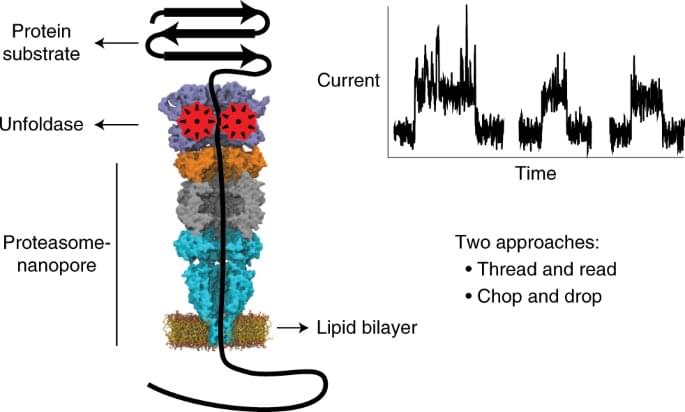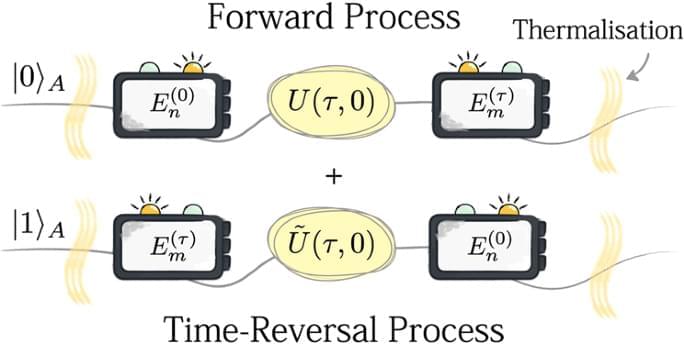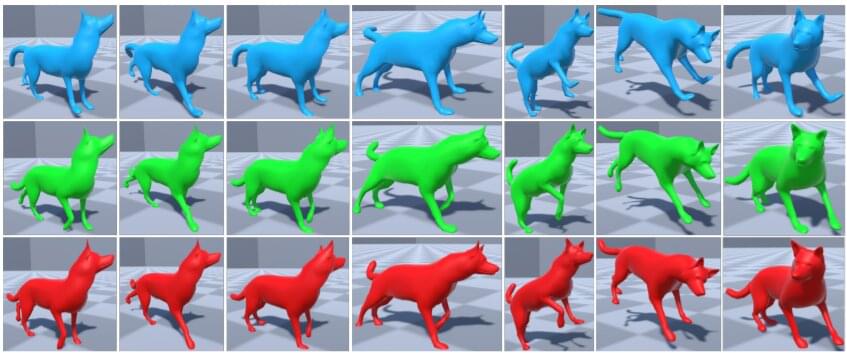MIT researchers design glue that mimics the sticky substance barnacles use to cling to rocks.



A team of researchers at the University of Groningen has developed a multicomponent nanopore machine that approaches single molecule protein sequencing—it uses a design that allows for unfolding, threading and degrading a desired protein. In their paper published in the journal Nature Chemistry, the group describes their nanopore machine, how it works and how close it comes to allowing single molecule protein sequencing. Yi-Lun Ying with Nanjing University has published a News & Views piece in the same journal issue outlining the purpose of macromolecular machines and the work done by the team with this new effort.
It has been a goal of chemists for many years to create a machine of some type that would allow easy analysis of individual protein molecules, similar to devices that have been created to sequence nucleic acids. Such efforts have been stymied by the high degree of complexity of protein molecules. In this new effort, the researchers have come close to achieving that goal. They have built a tiny (900 kDa) multicomponent nanopore machine that is capable of unfolding a given protein and then presenting it to a protein nanopore (a tiny cavity or pore).
The researchers built the machine by placing a chopper of sorts on top of material borrowed from a bacterium. The material works as a tunnel, directing bits from the chopper through a membrane that was designed to mimic the surface of a cell. The chopper breaks a protein into fragmented bits that are easily exported through the nanopore. As they do so, the fragments impact the flow of charged molecules, which leads to the generation of an electrical signal.

The idea of transparent solar windows almost sounds too good to be true, and it is, but not entirely. Researchers have been hammering away at the challenge of harnessing sunlight to generate electricity from see-through windows for years. The prize is acres upon acres of new sites for solar panels on buildings, without losing the energy-saving advantages of daylighting. Just look at any glass building and you can practically feel the blooming of the possibilities. The obstacles are many but it looks like a real breakthrough is finally at hand, so to speak.
Transparent Solar Windows, For Real
See-through solar cells have been bouncing around the CleanTechnica radar since at least 2010, when the possibility of creating a transparent solar window was beginning to emerge alongside thin film solar technology.
Gesture interface company Leap Motion is announcing an ambitious, but still very early, plan for an augmented reality platform based on its hand tracking system. The system is called Project North Star, and it includes a design for a headset that Leap Motion claims costs less than $100 at large-scale production. The headset would be equipped with a Leap Motion sensor, so users could precisely manipulate objects with their hands — something the company has previously offered for desktop and VR displays.
Project North Star isn’t a new consumer headset, nor will Leap Motion be selling a version to developers at this point. Instead, the company is releasing the necessary hardware specifications and software under an open source license next week. “We hope that these designs will inspire a new generation of experimental AR systems that will shift the conversation from what an AR system should look like, to what an AR experience should feel like,” the company writes.
The headset design uses two fast-refreshing 3.5-inch LCD displays with a resolution of 1600×1440 per eye. The displays reflect their light onto a visor that the user perceives as a transparent overlay. Leap Motion says this offers a field of view that’s 95 degrees high and 70 degrees wide, larger than most AR systems that exist today. The Leap Motion sensor fits above the eyes and tracks hand motion across a far wider field of view, around 180 degrees horizontal and vertical.
The new jelly ice cube is not plastic and won’t melt.

A team of physicists at the Universities of Bristol, Vienna, the Balearic Islands and the Institute for Quantum Optics and Quantum Information (IQOQI-Vienna) has shown how quantum systems can simultaneously evolve along two opposite time arrows—both forward and backward in time.
The study, published in the latest issue of Communications Physics, necessitates a rethink of how the flow of time is understood and represented in contexts where quantum laws play a crucial role.
For centuries, philosophers and physicists have been pondering the existence of time. Yet, in the classical world, our experience seems to extinguish any doubt that time exists and goes on. Indeed, in nature, processes tend to evolve spontaneously from states with less disorder to states with more disorder, and this propensity can be used to identify an arrow of time. In physics, this is described in terms of ‘entropy’, which is the physical quantity defining the amount of disorder in a system.

Taking a gas enclosed in a vessel as a pictorial example, the aforementioned state can be constructed by entangling the position of the piston with a further auxiliary quantum system, thereby establishing a quantum superposition of the following two processes: (i) a process wherein the gas particles are initially in thermal equilibrium confined in one half of the vessel by a piston, and the piston is pulled outwards, and (ii) the reverse process, in which the piston is pushed towards the gas, starting from an initial state where the gas occupies the entire vessel in thermal equilibrium.
We will now measure the work of the system undergoing the above-mentioned superposition of forward and time-reversal dynamics. In order to implement such a measurement, we formally construct a procedure described by a set of measurement operators forming a completely positive and trace-preserving (CPTP) map. In this regard, we will refer to a standard TPM procedure to measure work in quantum thermodynamic processes13. Implementations of the TPM in quantum setups25,26,27,28,29, as well as suitable extensions30,31,32,33, have recently received increasing attention. Our procedure can be seen as a generalisation of the TPM scheme to situations where different thermodynamic processes are allowed to be superposed, and can consequently interfere.
In the TPM scheme, work is defined as the energy difference between the initial and final states of the system, which are measured through ideal projective measurements of the system Hamiltonian implemented before and after the thermodynamic process associated with the protocol Λ34,35. This measurement scheme can be performed, individually, both for the forward and the time-reversal processes, enabling the construction of the work probability distributions P (W) and \(\tilde{P}(W)\) 0, respectively.

A team of researchers from Harvard University and Brigham and Women’s Hospital, Harvard Medical School, has developed a type of living ink that can be used to print living materials. In their paper published in the journal Nature Communications, the group describes how they made their ink and possible uses for it.
For several years, microbial engineers have been working to develop a means to create living materials for use in a wide variety of applications such as medical devices. But getting such materials to conform to desired 3D structures has proven to be a daunting task. In this new effort, the researchers have taken a new approach to tackling the problem—engineering Escherichia coli to produce a product that can be used as the basis for an ink for use in a 3D printer.
The work began by bioengineering the bacteria to produce living nanofibers. The researchers then bundled the fibers and added other ingredients to produce a type of living ink that could be used in a conventional 3D printer. Once they found the concept viable, the team bioengineered other microbes to produce other types of living fibers or materials and added them to the ink. They then used the ink to print 3D objects that had living components. One was a material that secreted azurin—an anticancer drug—when stimulated by certain chemicals. Another was a material that sequestered Bisphenol A (a toxin that has found its way into the environment) without assistance from other chemicals or devices.

Researchers at Trinity College Dublin and University of Bath have recently developed a model based on deep neural networks that could help to improve the quality of animations containing quadruped animals, such as dogs. The framework they created was presented at the MIG (Motion, Interaction & Games) 2021 conference, an event where researchers present some of the latest technologies for producing high-quality animations and videogames.
“We were interested in working with non-human data,” Donal Egan, one of the researchers who carried out the study, told TechXplore. “We chose dogs for practicality reasons, as they are probably the easiest animal to obtain data for.”
Creating good quality animations of dogs and other quadruped animals is a challenging task. This is mainly because these animals move in complex ways and have unique gaits with specific footfall patterns. Egan and his colleagues wanted to create a framework that could simplify the creation of quadruped animations, producing more convincing content for both animated videos and videogames.

Back in April, it was reported that Akon planned to build a futuristic “Akon City” in Uganda. Along with Akon City, Akon launched AKOIN, his very own cryptocurrency.
According to the AKOIN website, which includes Akon City details and explains how it fits into the “I’m So Paid” singer’s efforts to bring resources and technological opportunities to Africa, AKOIN is “a cryptocurrency powered by a blockchain based eco-system of tools and services designed for entrepreneurs in the rising economies of Africa.”